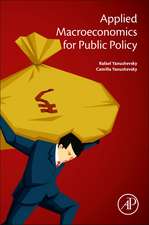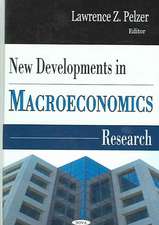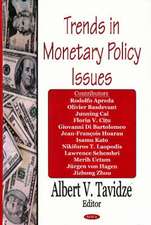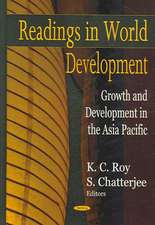Handbook of Macroeconomics: Handbook of Macroeconomics, cartea 2A-2B SET
Editat de John B. Taylor, Harald Uhligen Limba Engleză Hardback – 22 noi 2016
- Serves a double role as a textbook for macroeconomics courses and as a gateway for students to the latest research
- Acts as a one-of-a-kind resource as no major collections of macroeconomic essays have been published in the last decade
- Builds upon Volume 1 by using its section headings to illustrate just how far macroeconomic thought has evolved
| Toate formatele și edițiile | Preț | Express |
|---|---|---|
| Hardback (3) | 642.16 lei 15-29 zile | +114.30 lei 6-12 zile |
| ELSEVIER SCIENCE – 22 noi 2016 | 642.16 lei 15-29 zile | +114.30 lei 6-12 zile |
| ELSEVIER SCIENCE – 21 noi 2016 | 642.68 lei 15-29 zile | |
| ELSEVIER SCIENCE – 22 noi 2016 | 1265.57 lei 15-29 zile |
Preț: 1265.57 lei
Preț vechi: 1587.84 lei
-20% Nou
Puncte Express: 1898
Preț estimativ în valută:
242.24€ • 263.22$ • 203.62£
242.24€ • 263.22$ • 203.62£
Carte disponibilă
Livrare economică 24 martie-07 aprilie
Preluare comenzi: 021 569.72.76
Specificații
ISBN-13: 9780444594877
ISBN-10: 0444594876
Pagini: 2744
Dimensiuni: 191 x 235 x 142 mm
Editura: ELSEVIER SCIENCE
Seria Handbook of Macroeconomics
ISBN-10: 0444594876
Pagini: 2744
Dimensiuni: 191 x 235 x 142 mm
Editura: ELSEVIER SCIENCE
Seria Handbook of Macroeconomics
Public țintă
Graduate students and professors worldwide working in all subdisciplines of economics and finance. Secondary audience will include researchers working in macroeconomics and related areas, such as growth, economic behavior, international economics, and modeling.Cuprins
Section 1: The Facts of Economic Growth and Economic Fluctuation
1. RBC Methodology and the Development of Aggregate Economic Theory
2. The Facts of Economic Growth
3. Macroeconomic Shocks and Their Propagation
4. Macroeconomic Regimes and Regime Shifts
5. The Macroeconomics of Time Allocation
6. Who Bears the Cost of Recessions? The Role of House Prices and Household Debt
7. Allocative and Remitted Wages: New Facts and Challenges for Keynesian Models
8. Financial and Fiscal Crises
Section 2: The Methodology of Macroeconomics
9. Factor Models and Structural Vector Autoregressions in Macroeconomics
10. Solution and Estimation Methods for DSGE Models
11. Recursive Contracts and Endogenously Incomplete Markets
12. Macroeconomics and Household Heterogeneity
13. Natural Experiments in Macroeconomics
14. Accounting for Business Cycles
15. Incomplete Information in Macroeconomics: Accommodating Frictions in Coordination
16. New Methods for Macro-Financial Model Comparison and Policy Analysis
Section 3: Financial-Real Connections
17. Wholesale Banking and Bank Runs in Macroeconomic Modelling of Financial Crises
18. Housing and Credit Markets: Bubbles and Crashes
19. Macro, Money and Finance: A Continuous-Time Approach
20. Housing and Macroeconomics
21. Term Structure of Uncertainty in the Macroeconomy
22. Quantitative Models of Sovereign Debt Crises
Section 4: Models of Economic Growth and Fluctuations
23. Families in Macroeconomics
24. Environmental Macroeconomics
25. The Staying Power of Staggered Wage and Price Setting Models in Macroeconomics
26. Neoclassical Models in Macroeconomics
27. Macroeconomics of Persistent Slumps
28. Macroeconomics and the Labor Market
Section 5: Macroeconomic Policy
29. Challenges for Central BanksMacro Models
30. Liquidity requirements, liquidity choice and financial stability
31. Understanding Inflation as a Joint Monetary-Fiscal Phenomenon
32. Fiscal Multipliers: Liquidity Traps and Currency Unions
33. What is a Sustainable Public Debt?
34. The Political Economy of Government Debt
1. RBC Methodology and the Development of Aggregate Economic Theory
2. The Facts of Economic Growth
3. Macroeconomic Shocks and Their Propagation
4. Macroeconomic Regimes and Regime Shifts
5. The Macroeconomics of Time Allocation
6. Who Bears the Cost of Recessions? The Role of House Prices and Household Debt
7. Allocative and Remitted Wages: New Facts and Challenges for Keynesian Models
8. Financial and Fiscal Crises
Section 2: The Methodology of Macroeconomics
9. Factor Models and Structural Vector Autoregressions in Macroeconomics
10. Solution and Estimation Methods for DSGE Models
11. Recursive Contracts and Endogenously Incomplete Markets
12. Macroeconomics and Household Heterogeneity
13. Natural Experiments in Macroeconomics
14. Accounting for Business Cycles
15. Incomplete Information in Macroeconomics: Accommodating Frictions in Coordination
16. New Methods for Macro-Financial Model Comparison and Policy Analysis
Section 3: Financial-Real Connections
17. Wholesale Banking and Bank Runs in Macroeconomic Modelling of Financial Crises
18. Housing and Credit Markets: Bubbles and Crashes
19. Macro, Money and Finance: A Continuous-Time Approach
20. Housing and Macroeconomics
21. Term Structure of Uncertainty in the Macroeconomy
22. Quantitative Models of Sovereign Debt Crises
Section 4: Models of Economic Growth and Fluctuations
23. Families in Macroeconomics
24. Environmental Macroeconomics
25. The Staying Power of Staggered Wage and Price Setting Models in Macroeconomics
26. Neoclassical Models in Macroeconomics
27. Macroeconomics of Persistent Slumps
28. Macroeconomics and the Labor Market
Section 5: Macroeconomic Policy
29. Challenges for Central BanksMacro Models
30. Liquidity requirements, liquidity choice and financial stability
31. Understanding Inflation as a Joint Monetary-Fiscal Phenomenon
32. Fiscal Multipliers: Liquidity Traps and Currency Unions
33. What is a Sustainable Public Debt?
34. The Political Economy of Government Debt
Recenzii
"Macro is moving fast, partly because of technological progress and new data, partly because of the intellectual shocks triggered by the crisis. This handbook, like its predecessors, gives us the current state of the arts." --Olivier Blanchard, Massachusetts Institute of Technology
"The new volumes in the Handbook of Macroeconomics illustrates both the richness and the enormous breadth of modern research in macroeconomics. The chapters offer in depth surveys of critical areas, new empirical results to guide future researchers, analytical and computational tools for addressing macroeconomic issues, and examples of how these tools can be applied to advance our understanding of aggregate economic behavior. These volumes constitute an important resource for all macroeconomists, one that is certain to be widely used." --Carl E. Walsh, University of California, Santa Cruz
"This Handbook is the ideal starting point to get up to speed quickly on any major topic in Macroeconomics: What we have learned and what are the most pressing open questions." --Pete Klenow, Stanford University
"This remarkable collection belies uninformed critics who assert that modern macroeconomics was wrong footed by the 2007-2009 financial crisis. Articles in this book prove how, both before and after that crisis, working macroeconomists had rolled up their sleeves to study how financial frictions, incentive problems, incomplete markets, interactions among monetary, fiscal, regulatory, and bailout policies, and a host of other issues affect prices and quantities and good economic policies. This is an especially timely book." --Thomas Sargent, New York University
"The new volumes in the Handbook of Macroeconomics illustrates both the richness and the enormous breadth of modern research in macroeconomics. The chapters offer in depth surveys of critical areas, new empirical results to guide future researchers, analytical and computational tools for addressing macroeconomic issues, and examples of how these tools can be applied to advance our understanding of aggregate economic behavior. These volumes constitute an important resource for all macroeconomists, one that is certain to be widely used." --Carl E. Walsh, University of California, Santa Cruz
"This Handbook is the ideal starting point to get up to speed quickly on any major topic in Macroeconomics: What we have learned and what are the most pressing open questions." --Pete Klenow, Stanford University
"This remarkable collection belies uninformed critics who assert that modern macroeconomics was wrong footed by the 2007-2009 financial crisis. Articles in this book prove how, both before and after that crisis, working macroeconomists had rolled up their sleeves to study how financial frictions, incentive problems, incomplete markets, interactions among monetary, fiscal, regulatory, and bailout policies, and a host of other issues affect prices and quantities and good economic policies. This is an especially timely book." --Thomas Sargent, New York University













